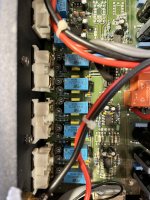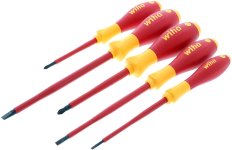Before I start I’m making you aware that I’m no electronics engineer, I can use a soldering iron to replace caps etc but other than that I have no fault finding skills.
So the amp works flawlessly when I’m using line 1 inputs ( my node ) but when using line 2 and now I’ve noticed line 3 the left channel is lower than the right until I turn it up and then it’s fine , could this be the source selector switch ( my Yamaha ca2010 did the same until I cleaned the switch)
Trouble is that the source selector switch on the Restek isn’t like anything I’ve seen before ( no little box if you get my meaning)
I’ve started recapping the amp for good measure, working my way from the back to the front ( I found 1 bloated cap ) .
Is this issue something obvious to you clever lot ?


So the amp works flawlessly when I’m using line 1 inputs ( my node ) but when using line 2 and now I’ve noticed line 3 the left channel is lower than the right until I turn it up and then it’s fine , could this be the source selector switch ( my Yamaha ca2010 did the same until I cleaned the switch)
Trouble is that the source selector switch on the Restek isn’t like anything I’ve seen before ( no little box if you get my meaning)
I’ve started recapping the amp for good measure, working my way from the back to the front ( I found 1 bloated cap ) .
Is this issue something obvious to you clever lot ?
I always recommend posting a service manual or a schematic. I made a Google search and didn't succeed in finding anything useful, but I'm sure my effort wasn't real thorough. An encouraging observation is that the microcontroller is obviously showing some health, so there may be a simple repair if you can locate the fault.
Good luck!
Good luck!
I'll followup with a couple of questions. Are the controls "manual"--- i.e. do they have detents and mechanical stops? Is volume control a pot? I can't tell much from the pic, but it does appear that there might be collection of relays that handle input selection. Is there a microcontroller or is control small scale logic?
The volume control knob has what I believe to be a motorised blue alps pot , the source selector switch appears to go straight into a small circuit board which has a ribbon cable coming from it and that goes into a socket which you can see in grey top left near the input sockets. I should have and will take more photos ( apologies)
Restek amplifiers are allegedly hand built so on their manufacturing scale, its likely that there is'nt any published service manual that's available outside their service agencies. The source selecting and routing is apparently done with all those little signal relays rather than hand operated multi-way switches, so signal selection and routing is most likely controlled by a microprocessor, with the specialised audio signal relays making/breaking the appropriate signal connections. The power output switching is done with the larger relays, capable of breaking substantial DC current as happens when a power amp. goes into melt-down.
Relay replacement is expensive but assuming the fault really is there (you can test by comparing the audio when you also short the active relay contacts ) and you want to fix it simply, you may only have one option - replace them all with reputable brand equivalents or better.
Relay replacement is expensive but assuming the fault really is there (you can test by comparing the audio when you also short the active relay contacts ) and you want to fix it simply, you may only have one option - replace them all with reputable brand equivalents or better.
Last edited:
This morning I noticed it was kind of fizzy between both channels, I powered it off and back on and then it was ok for 10 seconds before the left channel faded out to a lower level than the right.
Can't be certain, but it sounds like something other than a dirty relay. Can you repeat test with an different source selected?
The blue relays are source selector relays. I think you'll have to do something scary: it is called measuring. I would put a signal on both inputs and measure the signal at both inputs of the power amplifier. The brand FEME does not ring a bell but I would use Takamisawa relays anyway and replace all of them like Ian Finch already advised. One rarely experiences those to go bad.
When everything seems to be OK with signal levels the other possibility is bad speaker relays probably because cheap stuff was chosen although it supposedly is a Schrack type but who knows where these are produced nowadays. I experienced issues with that type of relay before and was surprised to see heavy pitting. Apparently old knowledge on the right metals/alloys for contacts is not available in China.
Don't think the more special/exclusive/expensive brands don't skimp on quality or that they are more reliable. Chances of high reliability are bigger with cheap products produced in high numbers as no one desires to have quality issues with 25.000 amplifiers.
BTW there is a cockroach in your amplifier.
When everything seems to be OK with signal levels the other possibility is bad speaker relays probably because cheap stuff was chosen although it supposedly is a Schrack type but who knows where these are produced nowadays. I experienced issues with that type of relay before and was surprised to see heavy pitting. Apparently old knowledge on the right metals/alloys for contacts is not available in China.
Don't think the more special/exclusive/expensive brands don't skimp on quality or that they are more reliable. Chances of high reliability are bigger with cheap products produced in high numbers as no one desires to have quality issues with 25.000 amplifiers.
BTW there is a cockroach in your amplifier.
Last edited:
The orange relays are the speaker relays.
You wrote that the line 1 input works O.K.
I would select input line 1 and observe if the amplifier behaves normal during some time.
Then, on low volume, gently knock on the orange relays, one at a time.
Does the volume change? Then the orange relay(s) is suspect.
If not, I would suspect the small blue relays for line 2 and line 3.
You wrote that the line 1 input works O.K.
I would select input line 1 and observe if the amplifier behaves normal during some time.
Then, on low volume, gently knock on the orange relays, one at a time.
Does the volume change? Then the orange relay(s) is suspect.
If not, I would suspect the small blue relays for line 2 and line 3.
Well I did start to think that myself but then why would it work for a short period if I turn the amp on and off . I’ll swap sources around tonight.
Cheers
Cheers
Excellent, I will try that tonight ( carefully)The orange relays are the speaker relays.
You wrote that the line 1 input works O.K.
I would select input line 1 and observe if the amplifier behaves normal during some time.
Then, on low volume, gently knock on the orange relays, one at a time.
Does the volume change? Then the orange relay(s) is suspect.
If not, I would suspect the small blue relays for line 2 and line 3.
Cheers
Thanks mateThe blue relays are source selector relays.
I think you'll have to do something scary: it is called measuring. I would put a signal on both inputs and measure the signal at both inputs of the power amplifier. The brand FEME does not ring a bell but I would use Takamisawa relays anyway. One rarely experiences those to go bad.
When everything seems to be OK with signal levels the other possibility is bad speaker relays probably because cheap stuff was chosen.
Don't be surprised that the screwdriver you probably will use will be attracted to the relay and will vibrate or the like. You will not be the first one to erroneously use a non isolated screwdriver that you then accidentally will drop in the amplifier. Arcing, BZZZZZ, BRRRRR, silence.
Tip: make sure to take out and reseat that black connector from source selectors to the volume control. Sometimes tinned contacts are chosen that may have oxidized. Take out the cockroach and give it a nice funeral. Use a soft brush to clean out the dust, maintenance = cleaning.
Tip: make sure to take out and reseat that black connector from source selectors to the volume control. Sometimes tinned contacts are chosen that may have oxidized. Take out the cockroach and give it a nice funeral. Use a soft brush to clean out the dust, maintenance = cleaning.
Last edited:
It takes a man with character to admit that. Chapeau!
Be wise, always use protection when doing silly things you may regret afterwards.
Be wise, always use protection when doing silly things you may regret afterwards.
Attachments
Last edited:
Can the blue Feme relays be taken apart and cleaned? I have found some the same and alternatives .
It was particularly dusty inside at that end of the amp.
It was particularly dusty inside at that end of the amp.
No. Don't even think of that. Just replace for known good quality sealed gold contact telecom relays with the same pinout and coil voltage. Bifurcated contacts would be nice to have too.
Our granddads knew exactly after trial and error what materials were best for contacts and the switches and relays they designed sometime are still in use today. Evil forces today use inferior materials for contacts in modern relays which explains bad relays/bad contacts/pitting. This causes positive bias or a self fulfilling prophesy of supposedly higher reliability of semiconductor switching…..
Our granddads knew exactly after trial and error what materials were best for contacts and the switches and relays they designed sometime are still in use today. Evil forces today use inferior materials for contacts in modern relays which explains bad relays/bad contacts/pitting. This causes positive bias or a self fulfilling prophesy of supposedly higher reliability of semiconductor switching…..
Last edited:
- Home
- Amplifiers
- Solid State
- Restek Fantasy II playing up a bit

